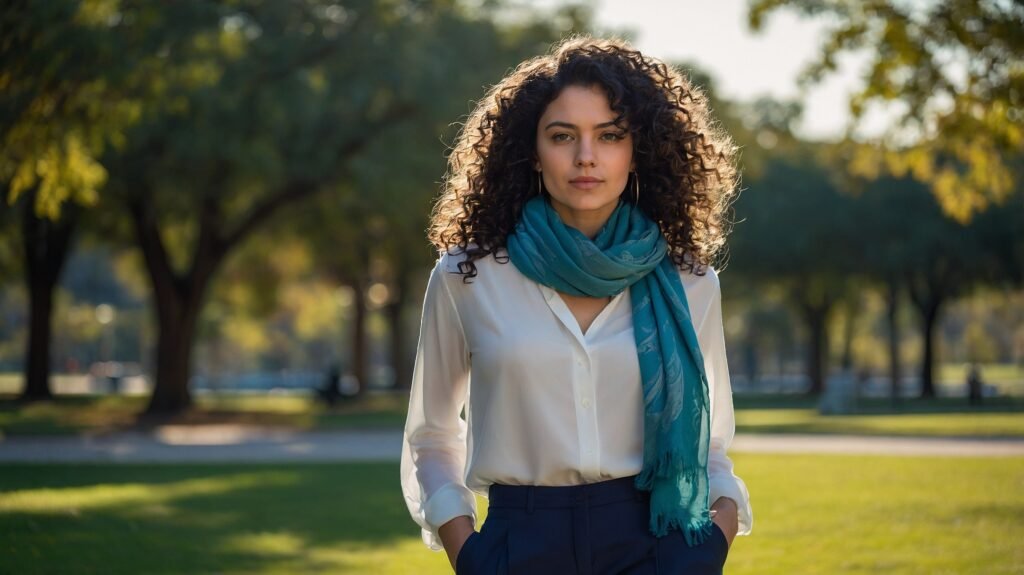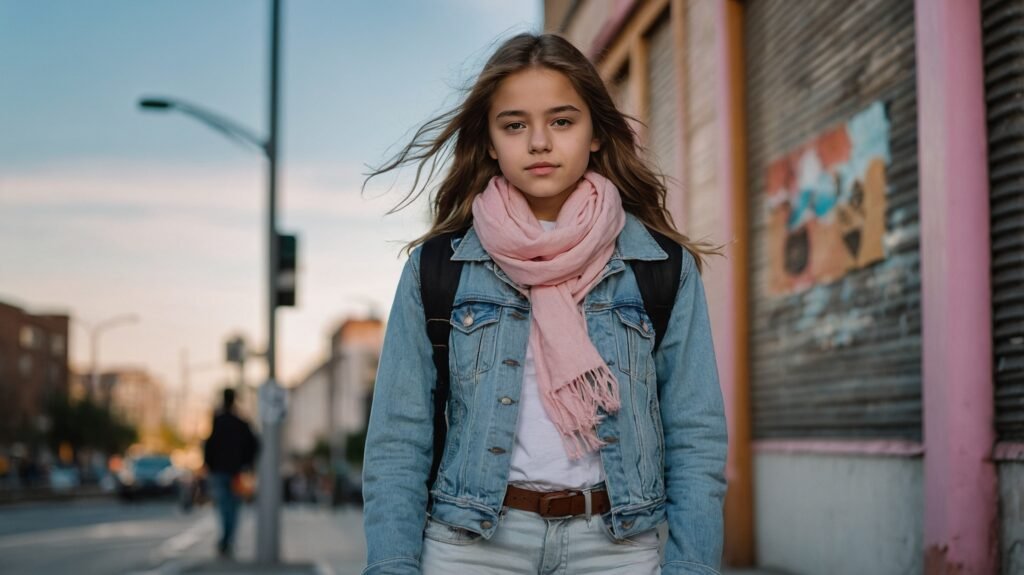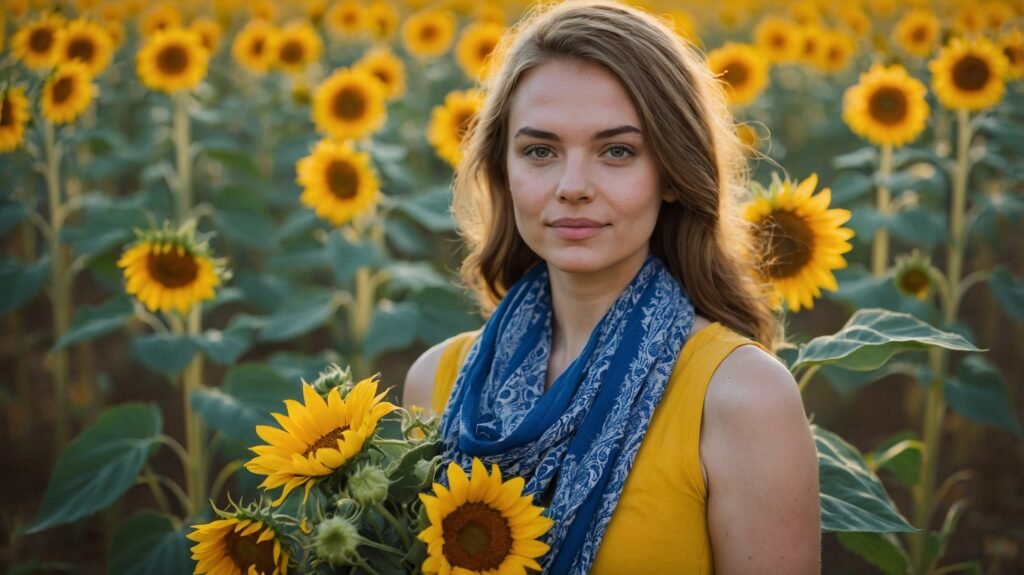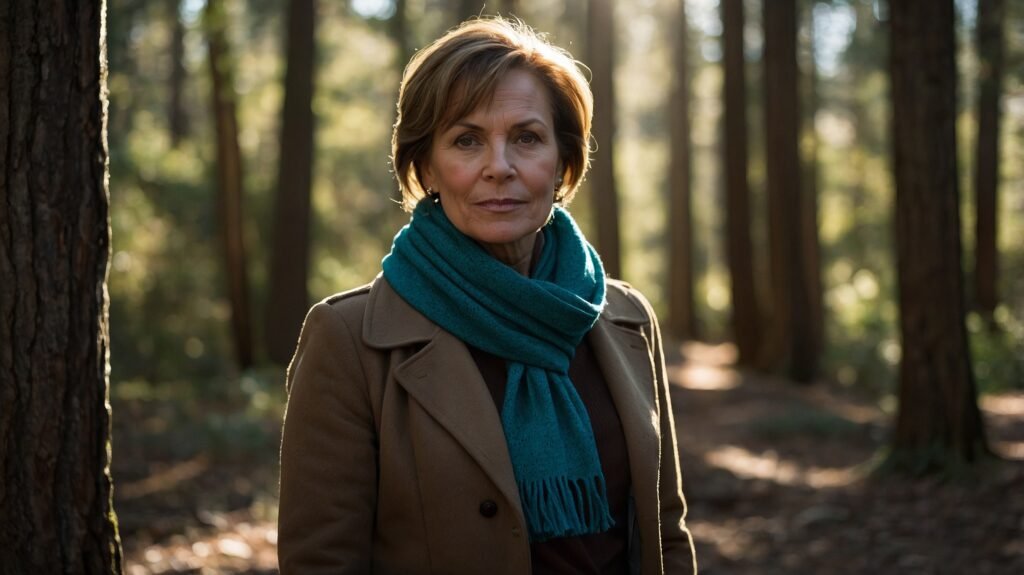Key Takeaways
- Choosing the right scarf color instantly elevates and transforms any outfit.
- Neutral scarves are versatile and easy to pair with bright colors or monochromatic looks.
- Bold, vibrant scarf shades add an energetic pop of color to neutral ensembles.
- Patterned scarves inject personality but can be trickier to style seamlessly.
- Consider your skin’s undertone when selecting the most flattering scarf colors.
- Coordinating scarf hues with your overall outfit colors creates a polished look.
- Don’t be afraid to experiment – playing with color combinations keeps things fresh.
- Accessories like scarves allow you to creatively refresh basics in your wardrobe.
Building an outfit around a chic scarf is an effortless way to look stylish and on-trend. A scarf’s vibrant color can make or break a look, transforming something drab into a total showstopper. But mastering the art of color coordination isn’t as simple as grabbing any old hue.

Pairing Scarf Colors with Clothing
Successful styling comes down to considering how your scarf’s color complements, contrasts, or clashes with the rest of your outfit’s color palette. You want your accessory to enhance the vibe, not overwhelm or compete for attention.
Go For Neutral Backdrops
Soft neutral scarf colors such as black, gray, tan, and ivory offer exceptional versatility for any wardrobe. These timeless shades easily complement a wide range of color palettes, from other neutrals for a chic, tonal outfit to vibrant colors for a bold, eye-catching contrast. For example, a camel scarf can effortlessly enhance a classic white t-shirt and blue jeans, adding a touch of luxury to your everyday style.
Embrace Vibrant Brights
Conversely, choosing a scarf in a vibrant jewel tone or bold color such as fuchsia, cobalt blue, or canary yellow can instantly refresh and brighten a neutral or minimalist outfit. These vivid scarf colors catch the eye and become the focal point of your look, while still pairing well with more subdued wardrobe staples. To achieve a stylish and balanced appearance, avoid mixing too many bright accessories at once—allow a single statement scarf to shine as the main accent.
Try a Print or Pattern
Printed or patterned scarves—featuring classic florals, bold geometric motifs, or striking abstract designs—add a vibrant pop of visual interest to any outfit. However, styling these statement scarves effortlessly can be a bit challenging. The secret is to let the printed scarf be the centerpiece of your look by pairing it with a simple color palette. Opt for streamlined solid colors or subtle tone-on-tone patterns in your clothing, so your fashion scarf stands out and truly shines.

Considering Your Complexion
Just as specific colors can make some people look radiant while leaving others looking washed out, choosing the most flattering scarf colors involves identifying whether your skin undertones are warm, cool, or neutral. Finding the best scarf shades for your complexion ensures your accessories highlight your natural beauty.
For Warm Tones
Those with yellow, golden, peachy or olive-toned complexions tend to glow in rich, earthy hues that share those warm undertones. Think cozy oatmeal, rusty terracotta, mustard yellow, or fiery scarlet reds. Pastels and super-cool tones can appear dull and draining on warm skin.
For Cool Tones
Icy crisp colors like cobalt and sapphire blues, royal purples, emerald greens and clean whites and blacks pop beautifully against cool undertones in the skin. Pink-toned rosy shades and lavenders also flatter cooler complexions. Very warm tones like oranges or yellows can clash.
Flatter Neutral Complexions
People with a balanced combination of warm and cool undertones enjoy the best of both worlds, as nearly any color will appear radiant on them. Experiment with rich jewel tones, earthy spice shades such as cinnamon and rust, soft pastel colors, or vibrant hues like kelly green and turquoise to create a versatile and complementary color palette for your wardrobe or makeup.

Consider the Color Wheel
Unlocking stylish color combinations that create cohesive looks is all about understanding how different hues interact and relate to one another on the color wheel. Some key complementary pairings to keep in mind:
Complementary Colors
Direct opposites on the color wheel, like blue and orange or red and green, create maximum vibrancy and high-contrast appeal when paired together. But they can also look jarring if not balanced properly, so use them judiciously.
Analogous Colors
These are neighbors on the color wheel, containing related undertones – such as blue and green or red and purple. Using analogous colors creates a natural, cohesive flow without the potential for clashing.
Triadic Color Schemes
Equally spaced in a pleasing triangle on the wheel, triadic palettes using any three colors (like orange, violet and kelly green) offer vibrant yet balanced styling when grounded with a dominant neutral.
So if your ensemble uses warm tones like reds, peaches and corals, your scarf colors could complement in the same balmy undertones. For cooler hues like chambray or periwinkle, look for like-minded azures and teals. Or let the scarf be a pop of coordinating contrast.
Dressing Room Scarf Auditions
Even with a strong sense of your most flattering colors, it’s always wise to take scarves into the dressing room for the ultimate “audition” against potential outfits. Hold them up to your face in natural lighting and take a critical look at how the hue interacts with your hair, makeup and complexion.
Does it enliven your features and make you look healthy? Or does it dull you out and seem slightly off? Trust your gut instinct – the right scarf shade should make you feel confident and radiant.
The same scarf you initially loved may fall disappointingly flat paired with certain outfits once in the room. An open mind is key as you experiment and tweak your combos. Start simple and build from there by accessorizing basic looks with various scarf options until you hit on winning color palette.

Color Impact on Clothing
While your complexion should take priority, the base tones and color family of your clothing also plays a pivotal role in complementing or clashing with a scarf.
For example, if your outfit is deep green, navy and forest tones, introducing a warm, reddish-orange scarf could fall flat or seem disjointed. But a botanical printed scarf harmonizing those same blue-green hues would make a much more cohesive match.
If you have a vivid red sweater dress, you may want something equally high-impact like a patterned navy and crimson scarf – not a washed-out pastel that would get drowned out. So consider the predominant clothing tones first, then build your scarf choice from that color base when unsure.
Seasonal Transitions and Your Scarf Palette
As we shift from season to season, rotating your “accent” scarf shades is a simple way to keep your overall wardrobe looking fresh and on-trend as temperatures fluctuate.
Spring into Pretty Pastels and Florals
Say goodbye to winter’s heavier shades and awaken pale, soft colors that mimic delicate spring blooms. Barely-there lilacs, peaches, misty blues and mint greens effortlessly brighten looks, while cheerful pops of buttercup yellow and candy apple red punch things up.
Summer’s Candy Box Brights
As the warm weather kicks in, so do vibrant citrus tones and saturated sherbet colors that dazzle against sun-kissed skin. Imagine a juicy watermelon pink scarf with white denim and espadrilles, or a brilliant kelly green wrap top with khaki shorts.
Autumn’s Cozy, Spicy Warmth
Orient your palette to the richly changing leaves and landscapes – rust, wine, forest green, caramel and pumpkin hues instantly evoke harvests and crackling fires. Let a luxuriously soft cashmere scarf in these moody shades elevate your everyday fall layers.
Winter’s Cool Sophistication
Cold temperatures cry out for chic drama and richness. Think sleek tones like inky indigo, pewter, burgundy and charcoal anchored by black, cream and bright winter white. Sleek and modern, these hues look striking draped over minimalist ensembles or cozy outerwear.

The Power of a Scarf Refresh
One of the easiest ways to reinvigorate basics and bare pieces hanging in your closet? Looping a vibrant printed or colored scarf into the mix! This subtle accessory delivers maximum impact by spicing up ho-hum looks with a jolt of vibrancy and personality.
Energize Jeans & Tee
Is your trusty jeans-and-tee combo feeling a little snoozy lately? Knot a happy yellow paisley print scarf around your neck to wake up the entire look and channel effortless French-girl chic. Not only does it imbue color, it also flatters the neckline.
Complement Your Glam Elements
Got an intricate smokey eye happening or just slicked on your go-to bold red lip? Pull it all together with a coordinating scarf in colors that enhance your makeup look. A scarf in vivid azure or cobalt tones makes those lid colors smolder and seem more striking.
Shift The Tone
Have a go-to dress that transitions from season to season just by switching up the styling? A switch in scarf accents can completely shift the entire attitude and occasion of that same piece.
For example, a sleeveless black sheath looks svelte and modern for day when paired with a crisp ivory scarf. But slip on your silk ruby and turquoise fringed scarf for evening and – bam! – it’s a festive cocktail look. The dress is the same, but the vibe and tone are utterly transformed.
Magnetic Mixing of Prints & Patterns
For extra style brownie points, one trick is learning to mix prints and patterns through your scarf choice for eye-catching richness and depth within a single outfit. There’s artistry in combining distinct motifs cohesively.
Start With a Tonal Base
The easiest way to anchor a print mix is with a dominant color or shade tying the separates together at their core. For a jacket, scarf, top and bottom all in red-based hues but different prints, there’s an underlying common thread. The patterns then feel intentional and elevated.
Check Your Scale
Contrasting print scales help too: Something oversized and bold matched with a delicate, ditsy pattern creates dynamic interplay. So a whimsical ditsy floral scarf wrapped with a loud graphic plaid jacket doesn’t appear overly busy, but rather achieves a fun, quirky balance.
Scarf as Pop of Pattern
Can’t quite get the mix right with multiple crazy prints at once? Let your scarf BE the sole pattern in your outfit instead, and make everything else sleek solids or a subtle jacquard. A scarf’s fluid fabric lends itself to prints, while letting the rest of your separates provide a clean backdrop.
Sample That Scarf Motif
If you adore the colors and patterns of a certain scarf, incorporate swatches of those exact motifs elsewhere in your look via pants, a purse, or another accent piece. The repetition creates chic cohesion with an artistic twist.

Beyond Neckwear: Infinite Scarf Styling
Scarves are meant to be versatile, not just standard neckwear – so don’t hesitate to style yours in unique, unexpected ways! Off-the-shoulder, knotted crop top, hair wrap, belt, head wrap or turban…There are infinite ways to integrate a printed silk scarf into an ensemble.
Sarong Wrap Skirt
Want to give a basic black tank and booties outfit an instant bohemian updo? Wrap and tie your printed scarf into a sarong-style skirt for an easy breezy global glam vibe.
Head Wrap Chic
Bad hair day? No problem. Fold your scarf on the bias and wind it turban-style or tie as a head wrap for a sleek, covered-up look that also happens to be très chic and elegant. Let spare ends drape down one side or use them to create a knot on top.
Effortless Halter Top
For a super simple way to turn a rectangle scarf into a classy halter top, just tie the two corner ends around your neck, then wrap and criss-cross the remaining fabric over your bust and back, securing with a knot or tucking into your skirt or shorts. So easy for beach or pool cover-ups.
Slip Dress Alternative
If you’re intrigued by the fancy slip dress trend but don’t want to bare too much skin, make your own luxe version using a silky rectangular scarf! Gather it at the shoulders with chic slide rings, belt the waist and voila – instantly elevated ensemble perfect for weddings, parties or date nights.
Summary Table
| Scarf Print/Color | Styling Notes | Outfit Vibe |
|---|---|---|
| Neutral solids | Versatile backdrop for bright pieces or streamlined monochrome | Minimalist, polished |
| Vibrant solids | Work best with solid, simple base pieces | Energetic, eye-catching |
| Ditsy prints | Pair with other small-scale prints and solids | Feminine, romantic |
| Bold patterns | Keep clothing prints minimal to avoid overwhelm | Eclectic, statement-making |
Conclusion
With an eye for color and style, that humble scarf in your closet transforms into a fashion superpower. By understanding how hues interact and harmonize, you can uplift any outfit with the perfect scarf accent that flatters you and your look. Trust your instincts, have fun experimenting with unexpected combinations, and tap into the creative confidence that comes when you truly understand your colors. After all, looking great has far less to do with passing trends than with empowering yourself through flattering, mood-boosting style choices. One fabulous scarf can change everything.

Frequently Asked Questions
How do I know if I have cool or warm undertones?
Look at the veins on your wrist – if they appear more blue/purple, you likely have cool undertones. If they read greener, you’re warm-toned. You can also examine the whites of your eyes for blue/red hints. Still unsure? Try draping yourself in jewelry-toned gemstone colors like ruby vs. emerald and see which makes your complexion glow.
Can I wear an orange or red scarf if I have reddish skin?
Wearing colors too closely matched to your exact skin tone can actually make you look washed out or ruddy rather than enhancing your glow. But that doesn’t mean you need to avoid warm hues altogether! Try adjacent shades on the color wheel like golden yellows or true reds rather than orangey reds.
What are some fail-safe colors for olive or tan skin tones?
With their balanced warm and cool tones, tan and olive complexions are incredibly versatile. For an easy win, opt for rich jewel tones like fuchsia, royal blue, amethyst and emerald which tend to look enlivening without clashing. Crisp neutrals like winter white or sleek black also pair beautifully.
How do I know if certain colors are overwhelming me?
While we all have colors we’re naturally drawn to based on our own instincts and preferences, the wrong bright or vivid hue can actually overpower your features and energy rather than complementing you. To gauge, take a selfie wearing the vivid scarf or outfit and take a step back to critically examine the overall impact impartially.

Is there a “best” print pattern to start with for beginners?
If mixing prints feels intimidating at first, begin with softer, more abstract patterns and nature motifs like paisley, modern florals, animal prints or ikat designs that have a tonal range and flow to them. Geometric prints with high contrast and harsh lines can sometimes look more jarring until you get the hang of combining them mindfully.
How can I coordinate colors and patterns for the office?
For professional settings, tread gently when combining prints and vivid hues – you want stylish sophication, not the risk of looking too loud or overpowering. A printed scarf is a chic, easy way to introduce pattern while keeping the rest of your look streamlined in polished neutrals or botanicals. Or, pick a scarf that brings out a single accent color in your tailored sheath or suit for an elevated feel.
What’s the best way to clean delicate silk/wool scarves?
Always check individual care labels, but in general silk items should be hand-washed or taken to a professional cleaner to avoid damage, shrinking or color bleeding. Wool scarves can go in a delicates cycle on your wash machine, but skip the dryer which can cause them to felt or shed. Refresh in between cleanings with a light steaming.

How many scarves are too many to own?
With their versatility in textures, prints and prices, you can never have too many beautiful scarves in rotation for different seasonal outfit needs! 30-40 scarves across a nice range of colors and fabrics would allow endless creative styling options. Go for quality pieces that make you happy and embrace your love of accessories without guilt.

Matthew Mansour, known in the fashion world as a storytelling virtuoso, weaves captivating tales centered around the mesmerizing universe of fashion hues. Possessing a sharp eye for detail, Matthew explores the profound layers of color combinations, turning the simple act of choosing an outfit into a lively adventure. His unique ability to blend emotion and innovation into his writings sets him apart in the sartorial sphere. Each article penned by him carries a touch of magic, inspiring readers to embark on a colorful odyssey through the diverse landscape of apparel shades.
Reviewed By: Joanna Perez and Anna West
Edited By: Lenny Terra
Fact Checked By: Marcella Raskin
Photos Taken or Curated By: Matthew Mansour

